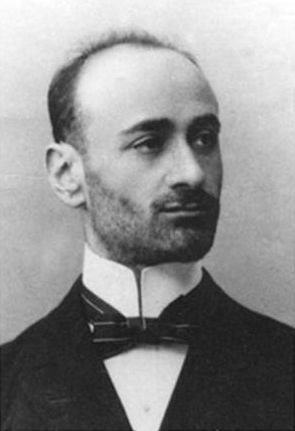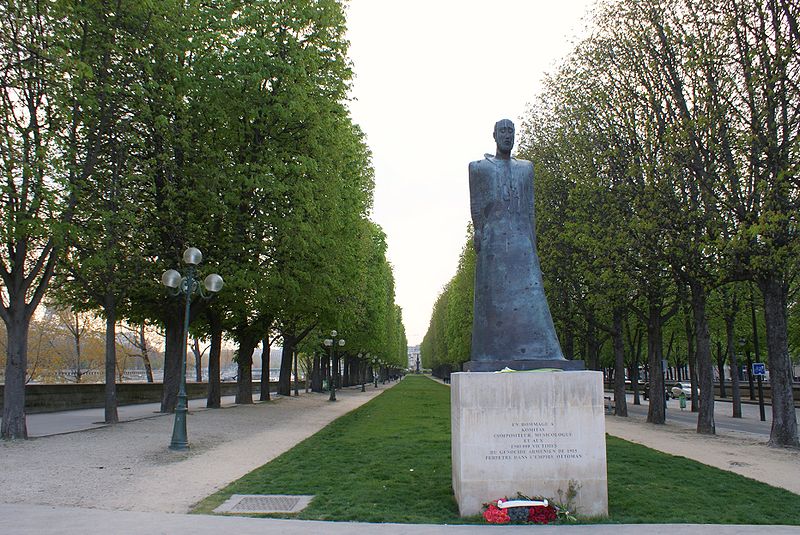<Back to Index>
- Composer, Singer and Musicologist Soghomon Gevorgi Soghomonyan (Komitas Vardapet), 1869
PAGE SPONSOR


Soghomon Gevorgi Soghomonyan (Սողոմոն Գևորգի Սողոմոնյան), commonly known as Komitas Vardapet (Կոմիտաս Վարդապետ, by Western Armenian transliteration also Gomidas Vartabed) or simply Komitas (Gomidas) (born on September 26 or October 8, 1869, in Kütahya, Ottoman Empire; died on October 22, 1935, in Paris, France) was an Armenian priest, composer, choir leader, singer, music ethnologist, music pedagogue and musicologist. Many regard him as the founder of modern Armenian classical music.
Komitas lost his mind after witnessing the 1915 Armenian Genocide and is ranked among the Armenian martyrs of genocide.
Soghomon (Gevorgi) Soghomonyan was born into a family whose members were deeply involved in music and were monolingual in Turkish. His mother died when he was one, and his father died ten years later. His grandmother looked after him until 1881, when a prelate of the local Armenian diocese went to Echmiadzin to be consecrated a bishop. The catholicos Gevork IV ordered him to bring one orphaned child to be educated at the Echmiadzin Seminary. Soghomon was chosen among 20 candidates and admitted into the seminary (where he impressed the catholicos with his singing talent) and graduated in 1893, after which he became a monk. According to church tradition, newly ordained priests are given new names, and Soghomon was renamed Komitas (named after the 7th century Armenian catholicos who was also a hymn writer). Two years later, he became a priest and obtained the title Vardapet (or Vartabed), meaning a "priest" or a "church scholar".
He established and conducted the monastery choir until 1896, when he went to Berlin, enrolled in the Kaiser Friedrich Wilhelm University and studied music at the private conservatory of Prof. Richard Schmidt. In 1899, he acquired the title Doctor of Musicology and returned to Echmiadzin, where he took over conducting a polyphonic male choir. He traveled extensively around the country, listening to and recording details about Armenian folk songs and dances performed in various villages. This way, he collected and published some 3000 songs, many of them adapted to choir singing.
His major work is Badarak (Divine Liturgy), still used today as one of the two most popular musical settings of the Armenian Church liturgy or mass, which he started composing in 1892 but never completely finished due to the upcoming World War I. For the basis of the work, he took chants sung by the eldest priests and upgraded it with typical ("cleaned" of foreign influences) Armenian music elements from his collected material. Today the best known version of Badarak is his favorite for a four - voiced male choir. It must be understood that the Komitas Badarak was not an original composition per se, but rather an arrangement of the pre-existing melodies in use by Armenian priests for the singing of the mass. The words certainly are not original but are the text of the Armenian mass, which has been used for centuries. Armenian Church music was traditionally monophonic, but Makar Yekmalian, Komitas, and several other musicians / composers in the 19th and 20th centuries arranged polyphonic versions of the pre-existing melodies. Some composers (but not Komitas or Yekmalian) created completely original musical settings of the liturgy as well.
He was the first non - European to be admitted into the International Music Society, of which he was a co-founder. He gave many lectures and performances throughout Europe, Turkey and Egypt, thus presenting till then very little known Armenian music.
From 1910, he lived and worked in Istanbul. There, he established a
300 member choir, Gusan. On April 24, 1915, the day when the Armenian
Genocide
officially began, he was arrested and put on a train the next day
together with 180 other Armenian notables and sent to the city of
Çankırı in northern Central Anatolia, at a distance of some 300 miles.
His good friend Turkish nationalist poet Mehmet Emin Yurdakul, the
writer Halide Edip, and the U.S. ambassador Henry Morgenthau intervened with the government, and, by special orders from Talat Pasha,
Komitas was dispatched back to the capital alongside eight other
Armenians who had been deported. Details of his deportation can be found
in Grigoris Balakian's Armenian Golgotha,
during which Komitas suffered tremendously and was afflicted with
traumatic neurosis. As of autumn 1916, he was taken to a hospital in
Constantinople, Hôpital de la paix, and then moved to Paris in 1919, where he died in a psychiatric clinic in Villejuif in 1935. Next year, his ashes were transferred to Yerevan and buried in the Pantheon that was named after him.
In the 1950s, his manuscripts were also transferred from Paris to Yerevan.
Badarak was first printed in 1933 in Paris and first recorded onto a digital media in 1988 in Yerevan. In collecting and publishing so many folk songs, he saved the cultural heritage of Western Armenia that otherwise would have disappeared because of the genocide. His works have been published in the Republic of Armenia in a thoroughly annotated edition by Robert Atayan. Lately, nine songs on German poetry, written during his stay in Berlin, have been excavated from the archives in Yerevan and interpreted by soprano Hasmik Papian.
The Yerevan State Musical Conservatory is named after Komitas. There also exists a worldwide renowned string quartet named after Komitas.
On July 6, 2008, on the occasion of Quebec City's 400th anniversary celebration, a bronze bust of Komitas was unveiled near the Quebec National Assembly (provincial legislature, Auteuil street) in recognition of his great input to music in general and to Armenian popular and liturgical music in particular.
In September 2008, the CD Gomidas Songs, sung by Isabel
Bayrakdarian and accompanied by the Chamber Players of the Armenian
Philharmonic and pianist Serouj Kradjian, was released on the Nonesuch
label. This CD is nominated for a Grammy Award in the Best Vocal
Recording category. A major North American tour by Ms. Bayrakdarian in October 2008 featured the music of Komitas, with concerts in Toronto,
San Francisco, Orange County, Los Angeles, Vancouver, Boston and New
York's Carnegie Hall. She was accompanied by the Manitoba Chamber
Orchestra conducted by Anne Manson, and pianist Serouj Kradjian. The Remembrance Tour
was dedicated to victims of all genocides and sponsored by the
International Institute for Genocide and Human Rights Studies (a
division of the Zoryan Institute).
- The central square of Ejmiatsin city is named after Komitas.
- Yerevan State Musical Conservatory is named after Komitas Vardapet.
- Komitas Avenue, the main thoroughfare of Yerevan's Arabkir District, is named after Komitas Vardapet.
- The writers' and poets' pantheon in Yerevan is named after Komitas.